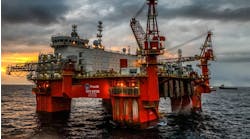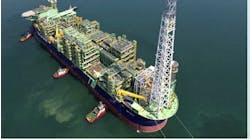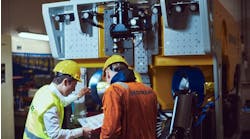Deepwater design specialist GustoMSC has developed two new concepts for mild environment operations. One is a dry tree production semisubmersible targeted at West Africa, a sector dominated hitherto by FPSOs and TLPs. The other is a monohull vessel, designed specifically for completion and intervention tasks, and the subject of a recent evaluation exercise by Stena Drilling.
The production semi, designated the FPU-40-DT, can handle production of up to 100,000 b/d and has been configured to accommodate dry tree risers. According to Project Engineer Robbert Kant, the semisubmersible concept provides ample space via its square deck shape, and should be relatively low cost to build and install. It is held in place by a 12-point mooring system.
West African deepwater fields are typically subject to low waves, but with fairly long (swell) periods. As the new platform is surrounded with a ring floater structure, its motion characteristics should be virtually independent of wave heading.
Process systems on the main deck comprise oil, water and gas separation, gas compression, gas dehydration, produced water treatment, water injection, and a flare module. The box-shaped deck is laid out partly as an open truss structure. Low-pressure hazardous production packages are located on the open lower decks. Accommodation, workspaces and machinery spaces are in the enclosed part of the deck box; and high-pressure hazardous equipment is placed on the upper decks. All maintenance-intensive kit is situated within easy reach of cranes.
Altogether 18 dry tree import risers and water injection risers are positioned within the moonpool at the deck box center. Dry tree risers are individually tensioned by hydraulically operated tensioners mounted on a reinforced structure on top of the moonpool at the main deck level.
The derrick equipment set (DES) is placed on a moveable substructure that travels on rails. The latter are mounted fore and aft of the riser moonpool on the main deck. For drilling activity the DES can move transversely with the substructure and longitudinally on rails on top of the substructure, providing access as required to all christmas tree locations. Tender-assist drilling can also be accommodated.
According to Kant, there is a range of options for the construction, depending on the project's requirements. The lower hull size has been dimensioned to fit inside an 80 m wide dry dock.
null
null
Drilling studies
In summer 2003, GustoMSC was invited by Stena Drilling to Gothenburg to present both its Gusto WIV series monohull vessel and MSC WSS series semisubmersible well servicing designs. GustoMSC was then asked to verify how these designs accorded with Stena's functional specs for a new intervention unit.
Following discussions with oil company clients, and another meeting this February at GustoMSC's headquarters in Schiedam (also attended by representatives from National Oilwell and Cameron), a customized concept design was completed.
The new design is based on the Gusto 10,000 drillship, of which four have been built. The WIV7500 well intervention vessel has an overall length of 170.5 m, a depth to main deck of 15.4 m, breadth of 29.4 m, a design draft of 9 m and a moonpool measuring 19.6 x 11.2 m. Its main features include:
- Completion and workover of subsea oil and gas wells in water depths of up to 7,500 ft
- Operable offshore West Africa, Brazil, and other similar deepwater regions
- Subsea workover capability includes slim hole and monobore drilling
- Able to handle subsea trees in parallel with subsea BOP operations
- Can accommodate both top drive and coiled tubing drilling
- Sailing speed of 12-14 knots (self-propelled) with a DP-3 positioning system
- Living quarters for up to 150 personnel.
Currently, a costing exercise is in progress, the aim being to validate the design in relation to present and future market requirements. According to a GustoMSC spokesman, the design has drawn keen attention from numerous oil companies with subsea completions in deepwater, "especially where workover and re-completion activities are expected in the near future, and economics play a major part in the decision to execute these activities."





